Coway Mighty Review
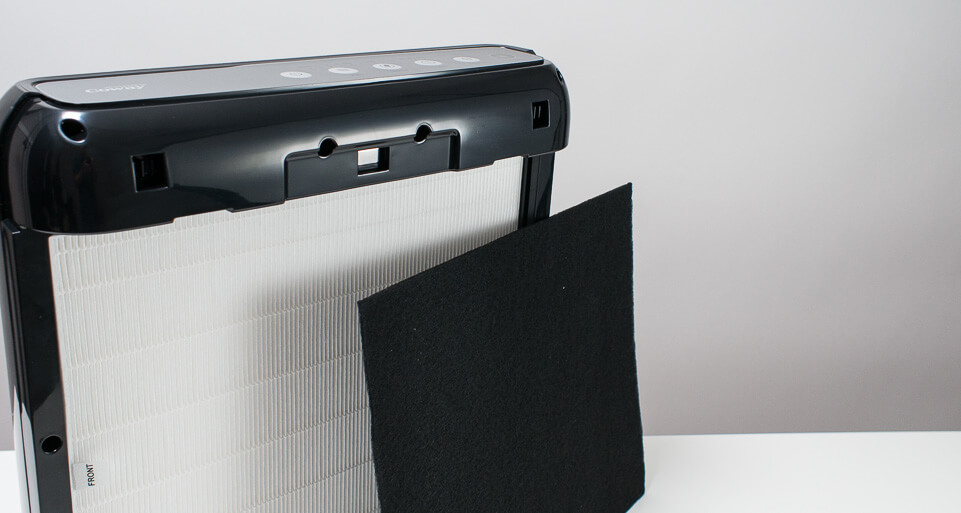
Feature Scores
Pros
- Good amount of air processing power (CFM) for the price – 250 CFM is sufficient power for rooms up to 300 sq. ft.
- Good energy efficiency especially on medium and low speed – CFM/watt ratio of approx. 20/1 on low fan speed which is one of the best ratios we’ve seen among all units tested. CFM/watt ratio of approx. 13/1 on medium fan speed at approx. 100 CFM of output. For comparison, most smaller units that output at 100 CFM on maximum fan speed have a CFM/watt ratio of only about 2/1 to 3/1.
- Also does very well in terms of CFM/dB ratios – a very quiet air purifier, especially on medium and low fan speed
- Good warranty length – 3 years. A lot of units have longer warranties – up to 5 years – but there are just as many that have a shorter warranty length – as little as 1 year.
- Light and small relative to its output (approx. 250 CFM)
Cons
- Carbon filter type, especially considering this model’s price. Carbon filter is comprised of a fibrous material coated with carbon. At same price point there are models available with carbon filters that contain actual carbon pellets that provide better gas filtration
- Small green light for most settings and a large air quality light (round circle on far right of control panel) – both lights cannot be dimmed or turned off
Editor's Score
Quick Facts
| Particle filter type | HEPA |
|---|---|
| Gas filter type | Carbon |
| Pre-Filter | Permanent washable |
| Output | Approx. 250 CFM |
| Air Movement | Front grille > pre-filter > carbon filter > HEPA filter > up and out of top of unit |
| Number of fan speeds | 3 – low, medium, high |
| Size | 18.5 in. tall x 17 in. wide x 9.5 in. deep |
| Weight | 12.5 lb. |
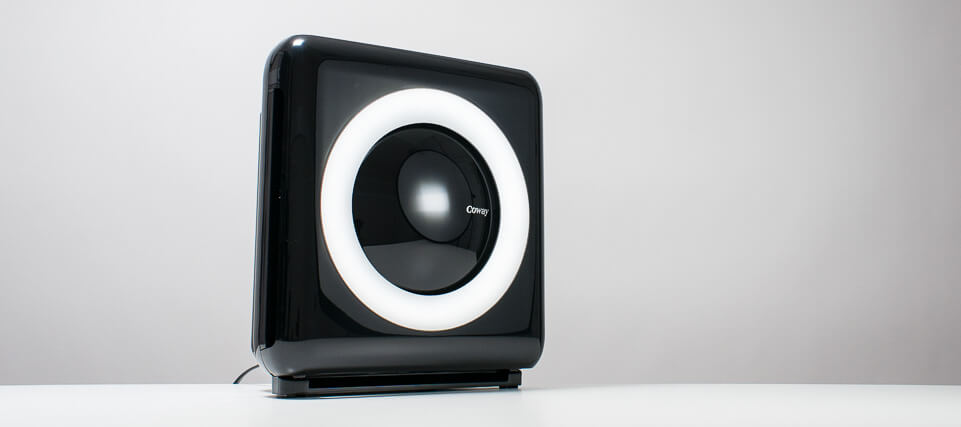



Analysis
A step by step breakdown of the Coway Mighty's performance.
Air Processing Performance
Test Results
In a 150 sq. ft. test environment, the Coway Mighty lowered room particle concentration from 10,000 particles per cubic ft. (relatively dirty air) down to 1,000 particles per cubic ft. (relatively clean air) in only 10 minutes. This was an expected result considering the unit’s HEPA filter (a high efficiency particle filter) and 250 CFM of output (meaning it can process 250 cubic feet of air every minute).
Another popular and highly rated 250 CFM unit we tested – the Winix 5500-2 – garnered a similar result in the same test. The Winix took 9 minutes to lower room particle concentration from 10,000 down to 1,000 particles per cubic ft.
Units with less output took slightly longer. For example, the approx. 140 CFM GermGuardian AC4825 took 23 minutes. Units with greater output were faster. For example, the approx. 430 CFM Coway AirMega 400s took only 4 minutes in the same test.
The second part of this test involved allowing the air purifier to continue to run on maximum fan speed until it achieved an ultra-low room particle concentration of only 100 particles per cubic ft. (as close to 0 particles per cubic ft. as our testing equipment and procedure allowed for). The Coway Mighty took an additional 13 minutes to get the room’s particle concentration down to 100 particles per cubic ft. (from 1,000 particles per cubic ft.) The Winix 5500-2 took an additional 6 minutes while the Coway AirMega 400s took an additional 9 minutes.
The main takeaway here, for our second test, is that all of the units above and all other 250+ CFM units we tested were able to get room particle concentration down to 100 particles per cubic ft., eventually. Most smaller lower output units we tested were not able to achieve this ultra-low concentration. For example, the GermGuardian AC4825 was only able to achieve 500 particles per cubic ft. The Honeywell HPA100 was only able to achieve 900 particles per cubic ft. The Blue Pure 411 was only able to achieve 600 particles per cubic ft.
Again, all units we tested with at least 250 CFM of output, including the Coway Mighty, were able to achieve an ultra-low room particle concentration of only 100 particles per cubic ft. in a 150 sq. ft. test environment.
Filter Analysis
Particle Filter
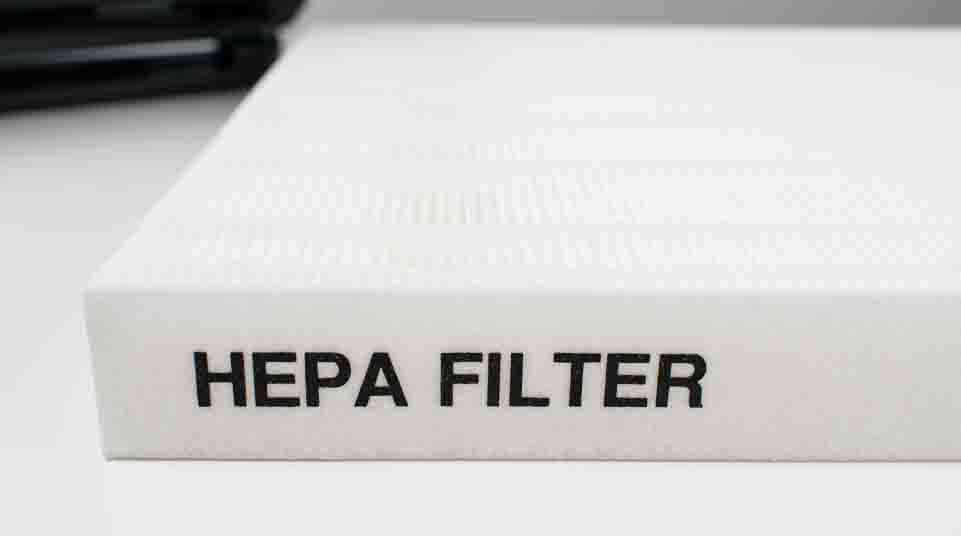
The Coway Mighty is equipped with a true HEPA filter. The HEPA filter is responsible for filtering out all particles – allergens, mold spores, pollen grains, etc.
HEPA is the industry standard for particle filtration. The Winix 5500-2, Coway AirMega, and GermGuardian AC4825 are all equipped with a HEPA filter as the primary particle filter. The HEPA filters on all of these units are all equally effective removing particles. They all have an efficiency rating of 99.97%. They all remove 99.97% of particles that travel through them.
Thus, you don’t get any better particle filtration spending more on more expensive options. What you do get, spending more, is usually greater output (CFM), more features, and better filtration in other areas like gas filtration and/or pre-filtration.
Gas Filter
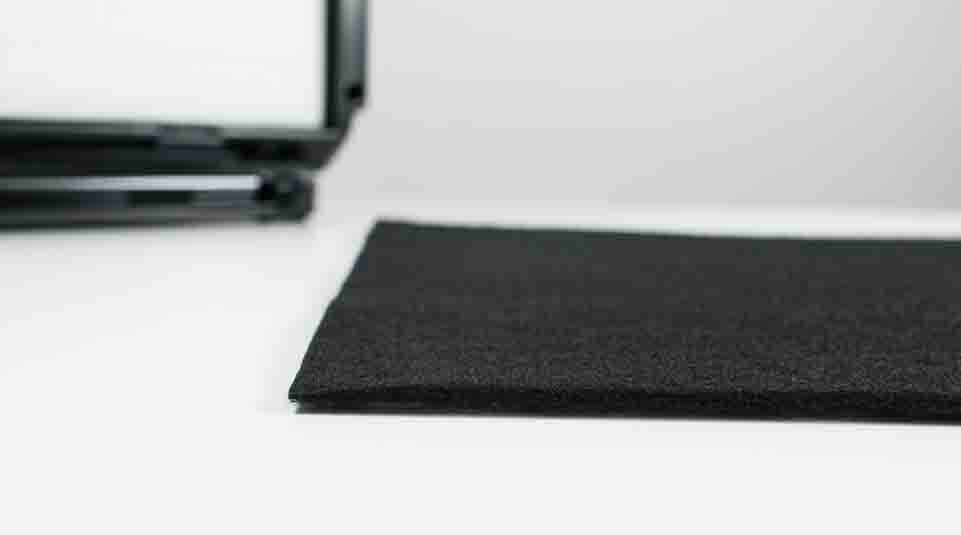
The Coway Mighty is equipped with a fibrous carbon filter. Two types of carbon filters dominate the market: fibrous filters and pellet-based filters.
The Mighty’s fibrous carbon filter is comprised of a fibrous material that is simply coated with carbon. Pellet-based filters are comprised of a plastic honeycomb frame that holds actual carbon pellets.
Pellet-based filters are more effective for removing unwanted gases like VOCs and odors. Thus, if gas filtration is a priority for you, we recommend a unit like the Winix 5500-2 that comes equipped with a pellet-based carbon filter over a unit like the Mighty that comes equipped with a fibrous carbon filter.
Pre-filter
The Mighty comes equipped with a washable pre-filter. The pre-filter filters out larger particles, extending the life of the HEPA filter which would otherwise saturate very quickly with these same larger particles.
Both the Winix 5500-2 and Coway AirMega come equipped with the exact same type of pre-filter. Cheaper units like the GermGuardian AC4825 generally do not come equipped with a separate pre-filter. Instead, the fibrous carbon filter on these units doubles up as a pre-filter. The problem with this setup is that the carbon filter has to be replaced, at cost, when it saturates with large particles. The Winix and Coway’s pre-filter can be washed for free.
Air Movement
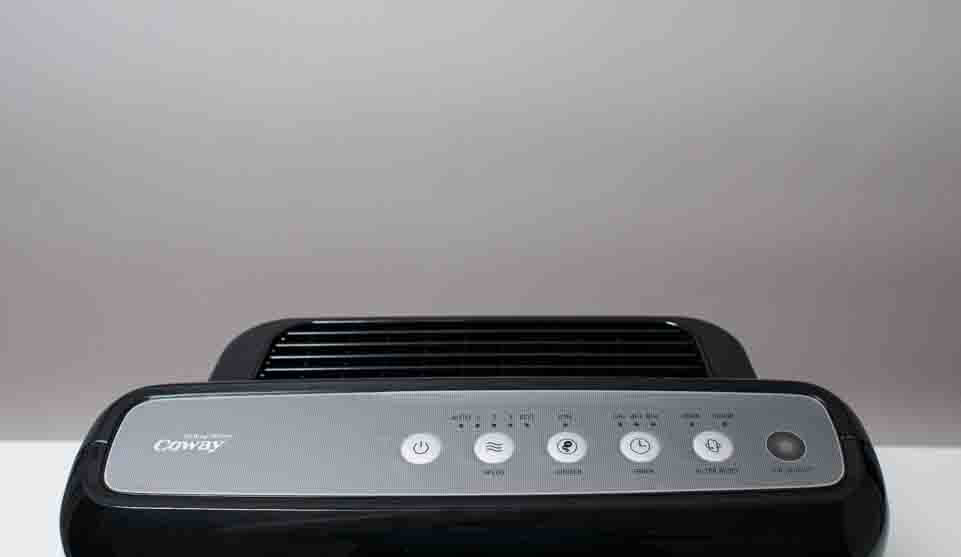
The Coway Mighty and Winix 5500-2 both have an identical output of approx. 250 CFM. More expensive options like the Coway AirMega will often have greater output. The AirMega’s output is approx. 430 CFM. Cheaper options will mostly have lesser output. The GermGuardian AC4825 has an output of approx. 140 CFM.
The Coway Mighy’s 250 CFM of output makes it a viable option to clean the air in rooms as large as 300 sq. ft. However, keep in mind that it has to be set to maximum fan speed to do so. And on maximum fan speed it’s very loud. Not any louder than comparable units like the Winix 5500-2 but still, very loud.
On lower fan speeds its output drops down to approx. 110 CFM on medium and approx. 70 CFM on low. On these lower fan speeds it runs much more quietly but its output is clearly much lower as well. And as output drops, so does area of coverage.
So on medium, the unit can only be used to lower particle concentration in rooms up to 150 sq. ft. On low, don’t expect it to properly lower particle concentration in a room any larger than about 100 sq. ft.
Now, keep in mind that there’s a difference between lowering particle concentration and maintaining particle concentration. The numbers above are for lowering particle concentration. You want to set the unit to high to lower particle concentration in rooms up to 300 sq. ft., medium in rooms up to 150 sq. ft., and low in rooms up to 100 sq. ft.
You can set the unit to medium to maintain a low particle concentration in rooms up to 300 sq. ft. Thus, our recommendation for everyday use in such a large space is that you first set the unit to high to lower room particle concentration and then set it to medium to maintain that low particle concentration.
Note: if you’re debating between buying the Coway Mighty and the Coway AirMega for a larger room we would strongly advise you to buy the Mighty. You can buy one Mighty for much less than an AirMega and test it in the room to see if it effectively lowers room particle concentration. If you find you need more CFM you can buy an additional Mighty and still be under the price of a single AirMega. Not only will you now have 500 CFM (with 2x Mighties) vs 430 CFM with a single AirMega 400 all at a lower total price, but you will be able to spread out the intake of dirty air and output of clean air in two different locations in the room.
Energy Efficiency
The Coway Mighty is one of the most energy efficient air purifiers we tested, especially on lower fan speeds.
On high it draws 72.3 watts of power. On this fan speed its CFM/watt ratio is 3.4 - meaning it processes 3.4 CFM of air for every watt it draws.
On medium it draws only 8.1 watts of power. On this fan speed it has a CFM/watt ratio of 13.
On low it draws only 3.2 watts of power. On this fan speed it has a CFM/watt ratio of 20.
The main takeaway here is the unit’s performance on medium and low fan speeds. Most other air purifiers we tested have a CFM/watt ratio on 2 or 3 CFM per watt at best. A CFM/watt ratio of 13 and 20 on medium and low, respectively, is exceptional.
The Coway’s closest competitor, the Winix 5500-2, is more energy efficient on its highest fan speed. The Winix draws considerably less power – 54.8 watts - with the same output – 250 CFM. This gives it a CFM/watt ratio of 4.6 vs 3.4 for the Coway on each unit’s highest fan speed.
The Coway is more energy efficient than the Winix on lower fan speeds. On lower fan speeds the Winix also draws less than 10 watts, much like the Coway. But its power draw is not quite as low as that of the Coway. For example, the Winix draws 5.5 watts on its lowest fan speed while the Coway draws only 3.2 watts at a very similar output.
Both of these units are much more energy efficient than most other air purifiers on the market. This is especially evident when you compare their performance to that of smaller units in smaller rooms.
In a 150 sq. ft. room you need to set a smaller unit like the GermGuardian AC4825 to its highest fan speed to properly lower particle concentration in the room. On this fan speed it draws 44.2 watts of power. The Coway Mighty or Winix 5500-2 can be set to a much lower fan speed to provide a similar output and lower particle concentration in the room equally well. On these lower fan speeds these units draw less than 10 watts of power.
In summary: in a typical small room application a smaller unit like the AC4825 on maximum fan speed draws over 40 watts of power while a larger unit like the Coway Mighty on lower fan speeds draws less than 10 watts of power. Thus, the latter option is the much better option for such applications if energy efficiency is a priority for you. In larger rooms smaller units won’t work at all.
Noise Output
The Coway Mighty has very similar noise output to that of the Winix 5500-2. The Coway was measured at 66.1 dB and the Winix was measured at 67.5 dB with each unit set to its highest fan speed.
On lower fan speeds, noise output drops dramatically on both units. Each unit was measured at 48.9 dB on its medium fan speed. On low, each unit was measured at approx. 40 dB.
Most other air purifiers we tested followed a similar trend – a noise output in the 60s on high and a noise output in the 40s on lower fan speeds. The difference between them is the level of output they provide on these different fan speeds.
For example, a smaller unit like the Honeywell HPA100 was measured at 68.7 dB on high – very similar to the 66.1 dB and 67.5 dB of the Coway and Winix on the same setting. The difference here is that the Honeywell has an output of approx. 110 CFM on this setting. The Coway and Winix have an output of approx. 250 CFM.
In a larger room the Coway and Winix have to be set to maximum fan speed to properly lower particle concentration but can be set to lower fan speeds to maintain that lower concentration. A smaller unit like the Honeywell simply cannot be used in such a room.
In a smaller room the Honeywell has to be set to maximum fan speed to provide sufficient output to properly lower particle concentration in the room. On this fan speed it was measured at 68.7 dB. The Coway and Winix can be set to a lower fan speed to provide the same level of output (CFM) as the Honeywell. On these lower fan speeds they were measured under 50 dB.
Thus, for small rooms, a larger unit like the Coway or Winix is the much better option if quiet operation is a priority for you. You can run them on lower fan speeds where they operate very quietly to effectively lower particle concentration in the room. Smaller units like the Honeywell HPA100 or GermGuardian AC4825 have to be run on maximum fan speed where they do not operate nearly as quietly.
Durability
The Coway Mighty is fairly well made with reasonably high quality parts although we do feel the Winix 5500-2 is better made with higher quality parts.
Offsetting this advantage for the Winix is its lesser warranty. The Winix only comes with a 1 year warranty. The Coway comes with a 3 year warranty.
Both units offer above average durability and long term reliability for their price point. Higher priced units are generally more durable but, they’re also higher priced. For example, Rabbit Air units come equipped with brushless motors and better quality plastics. However, they also retail in excess of $400.
Conversely, lower priced units generally offer lower durability and longevity. For example, the GermGuardian AC4825 retails for less than half the price of the Coway Mighty, but it’s also not nearly as well made. Placing both units side by side it’s clear that the Coway is the much better built unit and that it’s also made of higher quality materials.
Ease of Use
The Mighty’s control panel lights cannot be turned off. There’s a single green light for general settings and an air quality light that shows the current air quality in the room. Neither light can be dimmed or turned off.
The Winix 5500-2 also has a general setting light and an air quality light that cannot be dimmed or turned off.
A lack of control panel light control was quite common among the air purifiers we tested. Even expensive options like the Coway AirMega and IQAir HealthPro Plus have control panel lights that cannot be completely turned off. Surprisingly, some cheaper units do have the option. For example, all Levoit units and Honeywell HPA series units give you the ability to turn their control panel lights off. However, these cheaper options all have other major shortcomings that keep us from recommending them otherwise.

The Mighty is very light and portable considering its high output. Its smaller and lighter than the Winix 5500-2. It’s about 2 inches wider and about 2 inches deeper but considerable shorter – about 7 inches shorter than the Winix. It’s also about 4 lb. lighter – the Mighty weighs about 12.5 lb. while the Winix weighs about 16.5 lb.
Note that air purifiers, in general, are not very large or heavy appliances. Most units we tested were under 2 ft. tall, under 1.5 ft. wide, under 1 ft. deep, and less than 20 lb. So, while the Coway’s smaller size and lighter weight does make it more portable than competitors with similar output, keep in mind that those competitors are still highly portable.
The Coway comes with all of the features you’d expect in a unit at its price point – most notably an auto mode, an air quality sensor and display, and a timer. The Winix 5500-2 comes with all of these same features as well and also adds on a remote for good measure (the Coway doesn’t come with a remote).
Less expensive options are generally missing at least one or more of these features. For example, the GermGuardian AC4825 doesn’t come equipped with any of these features – no timer, no auto mode, no air quality sensor. The Honeywell HPA100 comes with a timer but no auto mode or air quality sensor.
More expensive options generally offer more features. For example, The Rabbit Air MinusA2 and Coway AirMega 400s both offer smart functionality – the ability to control all settings using your mobile phone.
Value
The Coway Mighty is a terrific value. At approx. $200 it provides HEPA filtration and approx. 250 CFM of output. Not to mention its excellent performance in both our noise output and energy efficient testing.
This latter testing is especially relevant when evaluating the unit’s value. With a CFM/watt ratio of 13 and 20 on medium and low fan speed, respectively, the Mighty provides 5 to 10 times the energy efficiency of most other air purifiers we tested that max out at a ratio of 2 or 3 CFM/watt. Greater energy efficiency equates to getting more (more CFM) for what you’re spending ($ for watts), which is exactly what value is all about.
The Mighty also has very affordable replacement filters. A replacement filter set includes 2x carbon filters and a single HEPA filter. A set for the Mighty usually costs close to $40 while it’s closer to $50 for the Winix 5500-2. Keep in mind, though, that the 5500-2’s carbon filter is pellet-based. So while you do pay less for replacement filters for the Coway, you are getting a much lower quality gas filter as part of the filter set. The Winix also costs about $50 less at retail which offsets its higher filter costs for the first few years of ownership.
Less expensive options like the GermGuardian AC4825 do retail for less and have slightly cheaper filters (because the filters are smaller) but they also have much lower output (CFM). These units are also less energy efficient and noisier than a larger unit like the Coway or Winix in smaller rooms (up to 150 sq. ft.). And because of their lower output cannot be used effectively in larger rooms (up to 300 sq. ft.).
More expensive options like the Coway AirMega retail for quite a bit more and usually have more expensive filters but they often provide greater output and/or extra features. If you need the greater output, we would recommend two Coway Mighties at a total price of around $400 with a total output of approx. 500 CFM spread out around a room over one Coway Airmega at well under 500 CFM for approx. the same price of $400. If you want extra features like wireless control via an app, you’ll have no choice but to move up to a more expensive option like the AirMega.
Verdict
Our bottom line recommendations.
The Coway Mighty is one of the best air purifiers we’ve tested. Its positives greatly outweigh its negatives. It really is a great all-around air purifier.
Its biggest competition is probably the Winix 5500-2. The Winix normally retails for about $50 less at the same output. With Winix, like the Coway, comes equipped with a HEPA filter for particle filtration. But the Winix has a better carbon filter – pellet-based – for gas filtration. The Winix also comes with a remote – if that’s important to you.
The Winix does have a shorter warranty – only 1 year – but our inspection of both units lead us to believe the Winix is the better built of the two with slightly better quality parts.
In terms of energy efficiency and noise output both units performed very similarly in our tests.
All things considered, if we had to recommend only one option between the two, we would probably give the nod to the Winix. BUT that doesn’t make the Coway a bad option. It’s still a very good air purifier and we don’t think you’ll regret your purchase buying one of these units.
Add a Comment
Have a question or comment? Let us know below.

Comments (1)
The latest models now include the ability to switch off the panel lights.